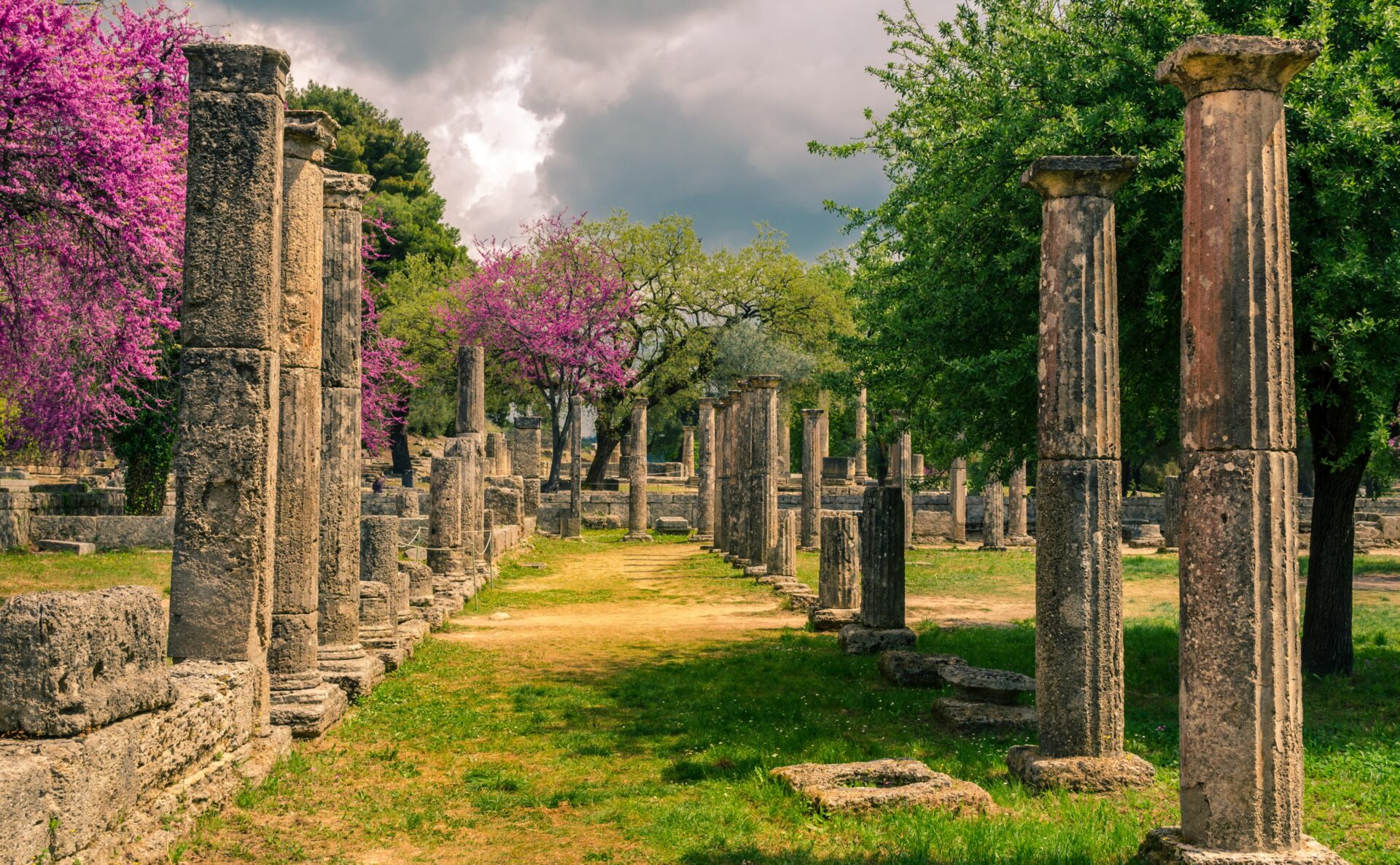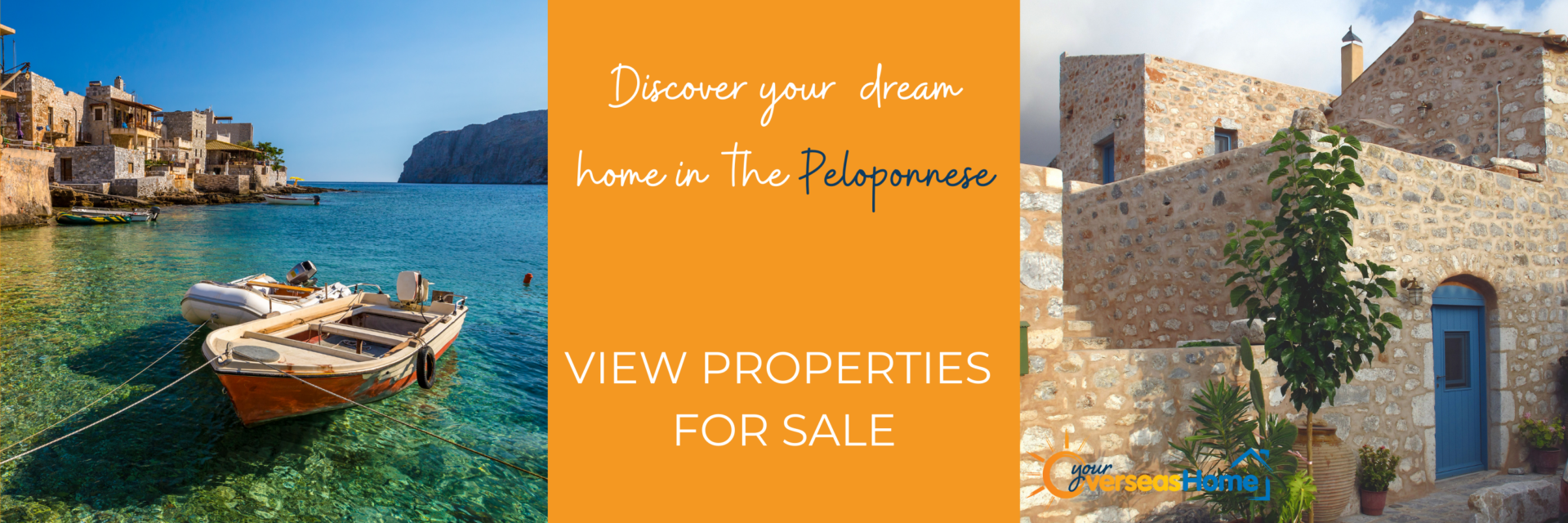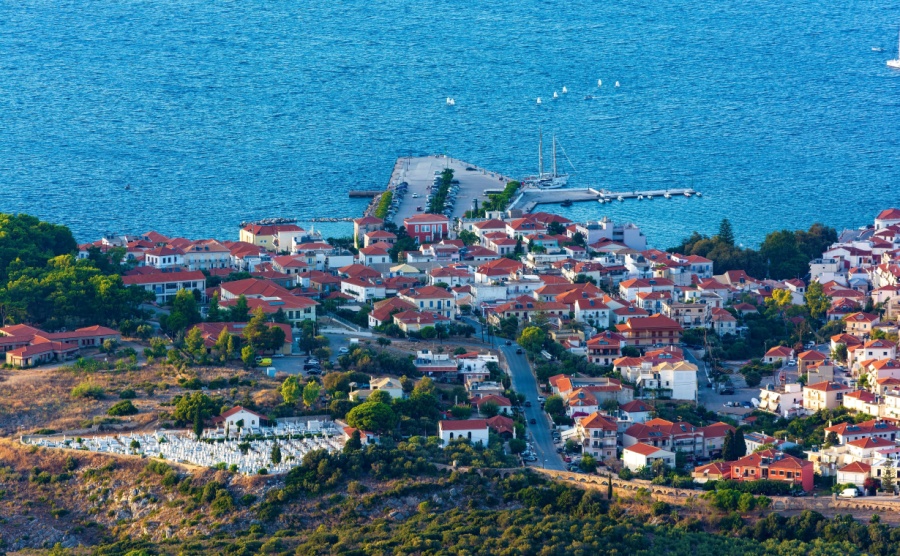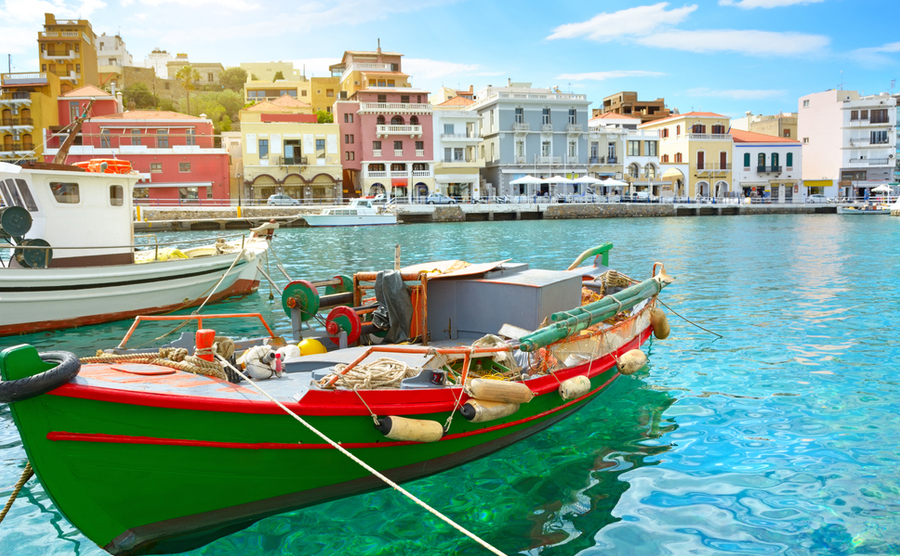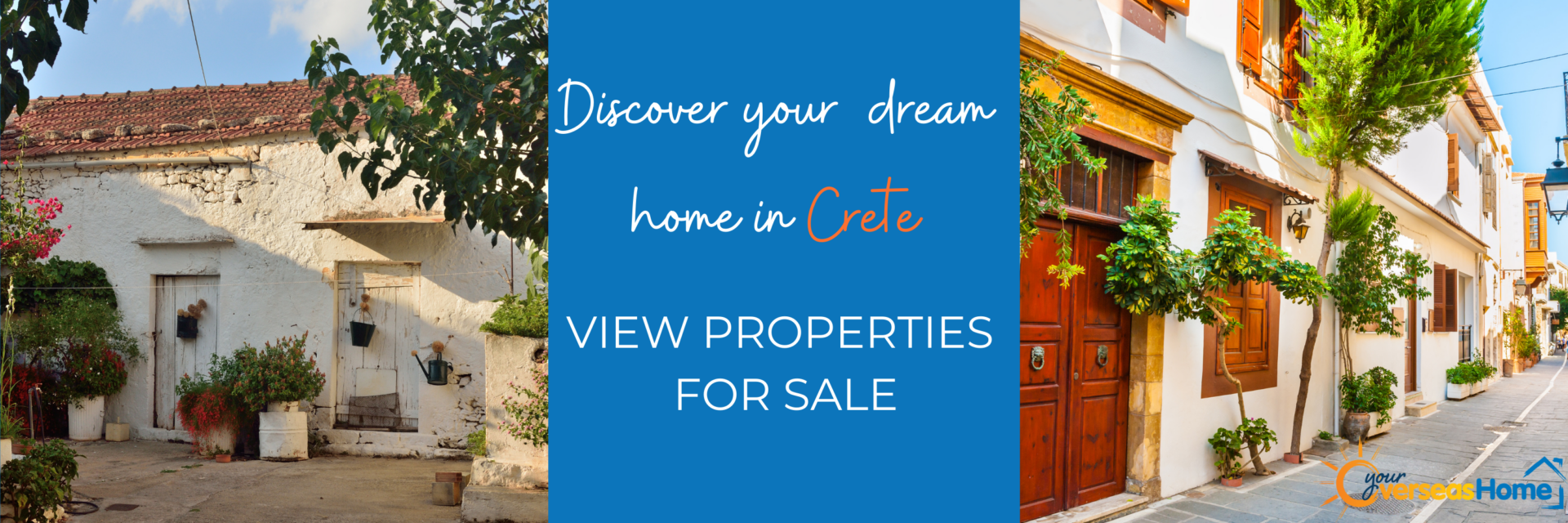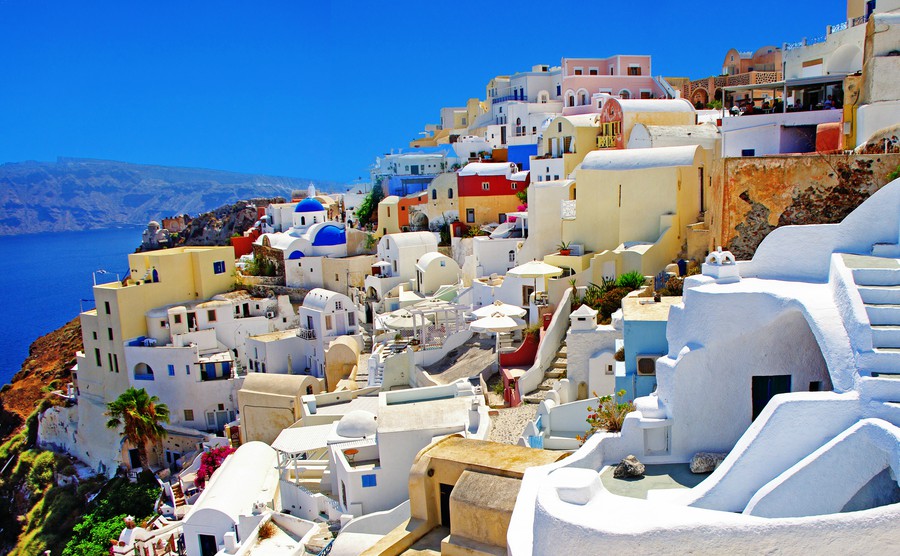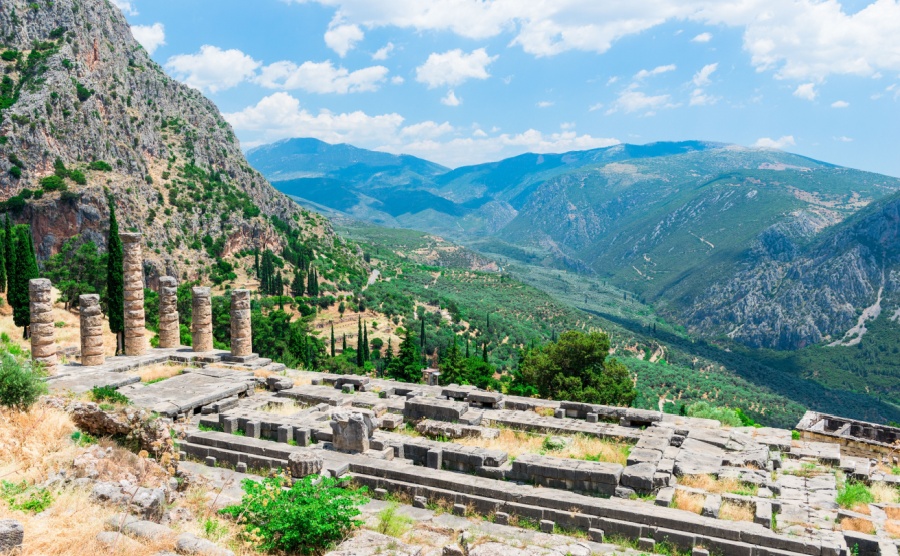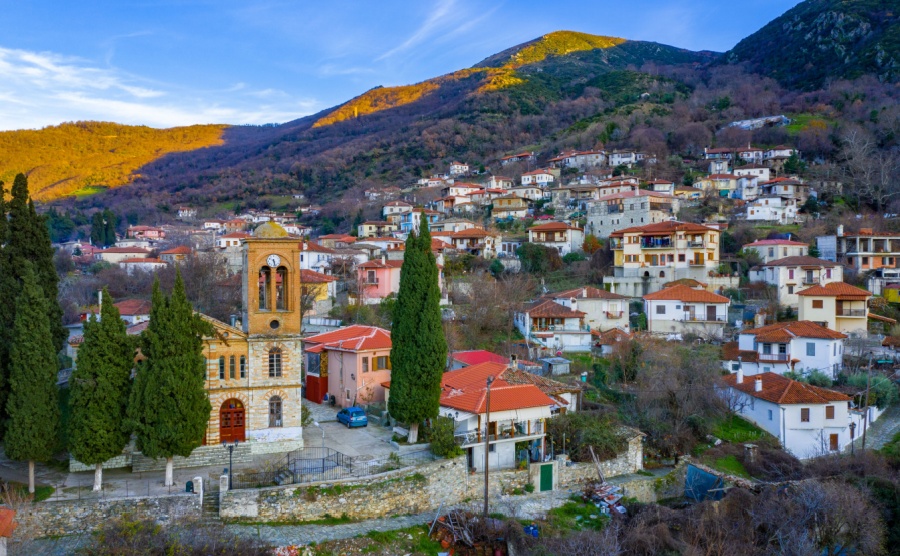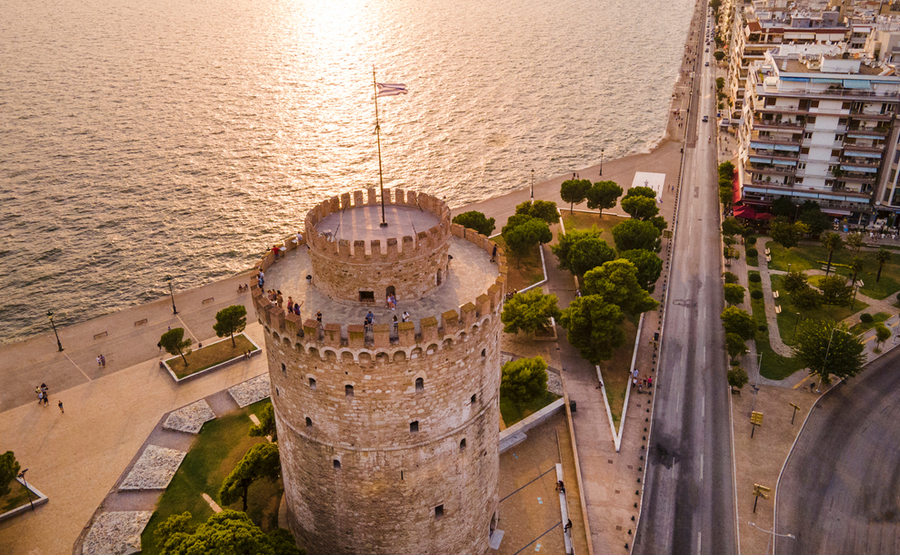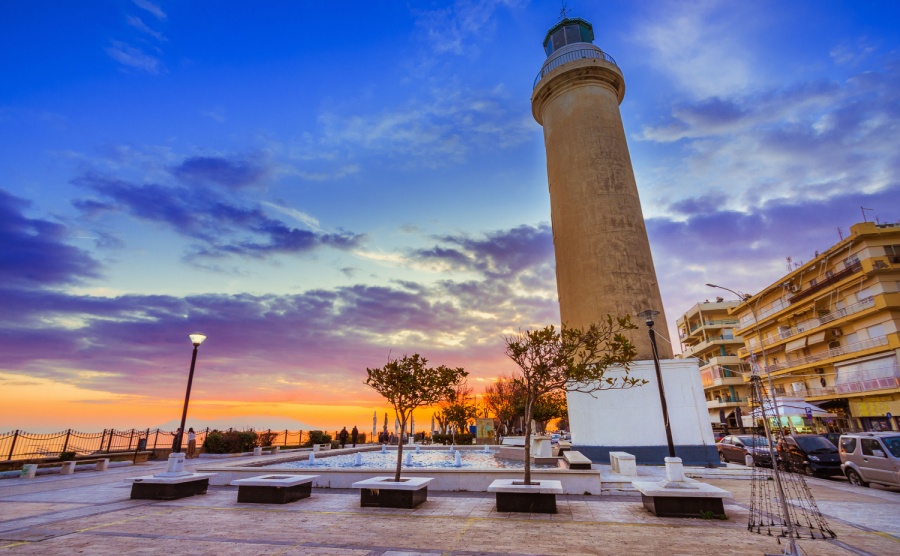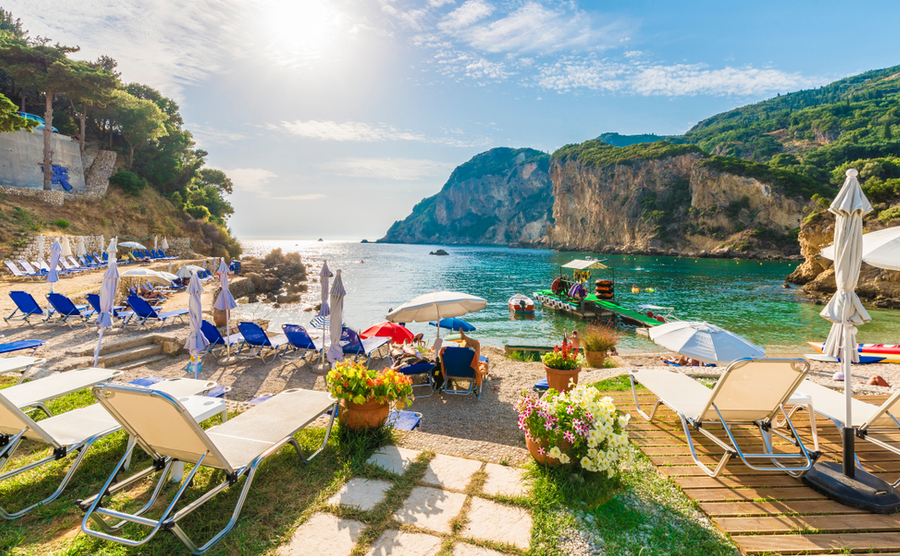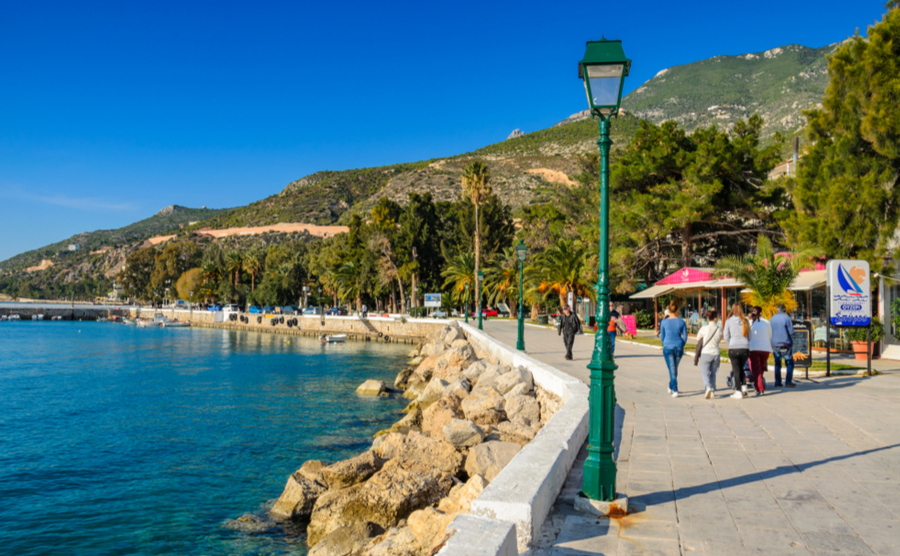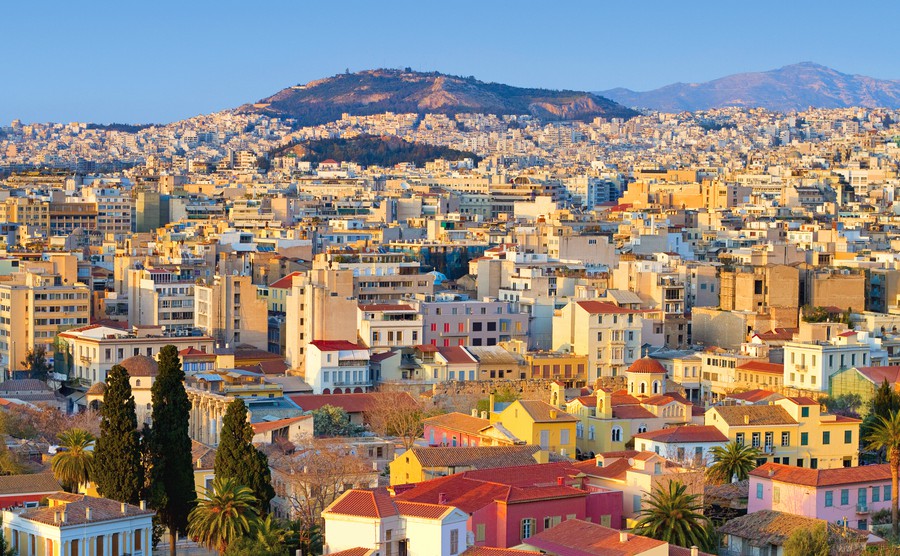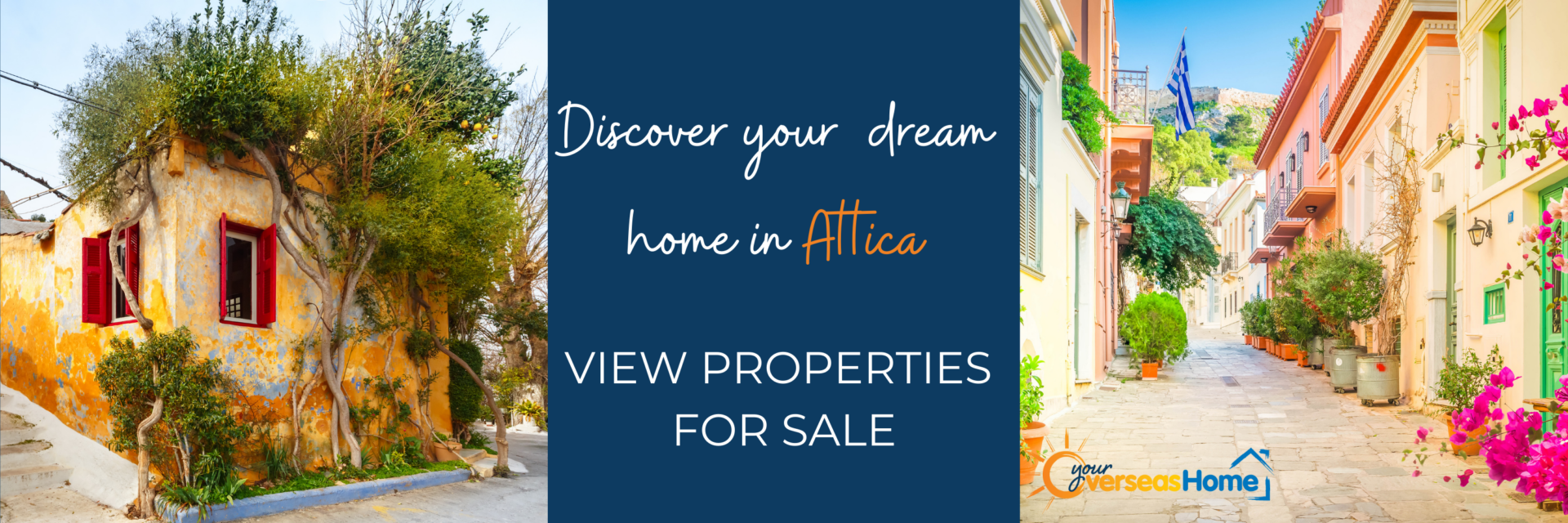The Olympic flame was carried by runners in a relay around Greece, before heading to this years host city in Paris, France. The Olympic flame, the olive branch and the dove are all used to symbolize peace and friendship among nations. Following its journey is a great way to explore Greece and learn some history.
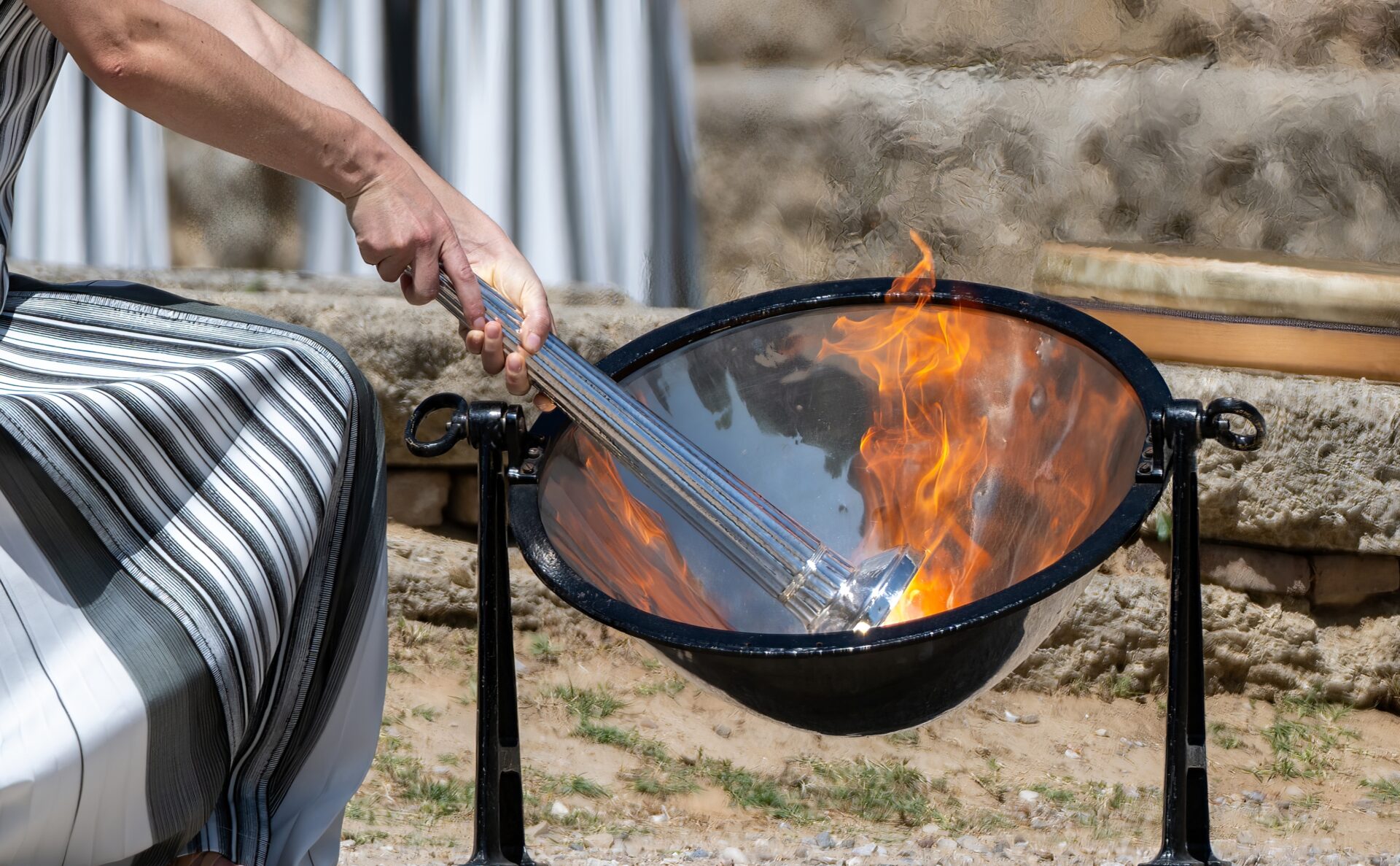
Olympia, Greece – April 15, 2024: Final dress rehearsal of the Olympic flame lighting ceremony for the Paris 2024 Summer Olympic Games in Ancient Olympia, Greece. Source: Ververidis Vasilis/ Shutterstock.
The Greek towns the Olympic flame travelled through in 2024 all gave the runners a very warm welcome, demonstrating the friendliness the Greek people are famous for. Like the Olympic messengers of old, who proclaimed the ‘sacred truce’, the relay runners still bring a message of peace to every village, city and historic site on the route.
Find homes in Greece via our property portal.
The Sacred Truce
The tradition of the truce or “Ekecheiria” was established in Ancient Greece in the 9th Century BC. Citizens of Elis would travel throughout Greece to pass on the message. During the period of the truce, the athletes, and spectators, could travel in total safety to participate in, or attend, the Olympic Games.
Igniting the Olympic flame
In front of the temple of Hera, at Olympia in the Peloponnese, the flame is lit by the High Priestess. She asks Apollo, the god of the sun, for help in lighting her torch with the sun’s rays caught on a parabolic mirror. The High Priestess is accompanied by priestesses, represented by a group of young Greek dancers in long dresses in the style of ancient Greece.
The Olympic flame is then placed in an urn and brought to the ancient stadium by Hestiada (the priestess keeper of the fire), where it is handed over by the High Priestess to the first torchbearer along with an olive branch. However, during the ancient Olympic Games, the flame would have remained lit throughout the Games in a sanctuary in Olympia known as the Prytaneum.
The Torch Relay
The Olympic Torch Relay, transports the flame from ancient Olympia to the host city of the modern Olympic Games. In an eleven day relay more than 550 torchbearers carried the flame through various locations across Greece. Finally arriving at the Panathenaic Stadium in Athens, where the modern games were born.
In 2024, the aim was to cover as much of Greece as possible and visit the most important archaeological sites. Along the way they passed through a varied landscape and beautiful countryside. A journey that should inspire us all to explore corners of Greece we may not have seen before.
Day 1 – Western Peloponnese
Olympia – Amaliada – Ancient Ilida – Gastouni – Pyrgos – Zacharo – Filiatra – Pylos
The Olympic Games took place in Olympia every four years from 776 BC to 393 AD. Following the torch lighting ceremony at Olympia in 2024, the torch then travelled through several villages on it’s way to the picturesque seaside town of Pylos. This beautiful seaside town is spread around the Bay of Navarino, and has two impressive forts and lovely sandy beaches. Located on the west coast of the Peloponnese, Pylos is around 52km from Kalamata, and its airport.
Day 2 – Eastern Peloponnese and Piraeus
Pylos – Methoni – Koroni – Mycenae – Nafplio – Piraeus
On Day 2, the Olympic flame started off from the little port town of Pylos. It was then taken to the large fortress of Methoni, before travelling via the Navarino Hills to Sparta, where it was met by people dressed in Spartan costume.
The flame then Passed through Tegea, and the large town of Tripoli. Where they were greeted by many excited children. While travelling through the eastern Peloponnese it was important to take a detour up into the hills to visit the archaelaeological site of Mycenae. Mycenae and the Tiryns were two of the greatest cities of the Mycenaean civilisation.
Close by is the popular town of Nafplio. Here a large crowd gathered, with a marching band and people dressed in traditional costume, to welcome the flame into this elegant coastal town. Nafplio has a lovely atmosphere for year round living, and tourists enjoy visiting the castle on the hill and the nearby beaches.
Another ancient site that couldn’t be missed on the way to Pireaus, was Nemea. The first Panhellenic Nemean games took place here in 573 BC, and were held at the Stadium every two years. Nemea was one of four sites for the competitions, the other sites were Delphi, Isthmia, and Olympia.
Day 3 – Crete and Dodecanese
Kastellorizo – Agios Nikolaos – Knossos – Heraklion – Rethymno – Chania
The Olympic flame started its journey through the Island of Crete at the charming village of Kastelorizo, which stretches around a lovely bay. Traditional Greek music and dancing gave the relay a good send off to Agios Nikolaos, where many people gathered to watch this momentous occasion. In recent years Agios Nikolaos has become one of the most famous seaside resorts on Crete. As well as beautiful beaches it has a small lagoon called Lake Voulismeni, with restaurants on the waterfront.
On the way to the city of Heraklion the Olympic flame paid a visit to The Palace of Knossis. This important archaeological site is the second most visited in Greece. Once the capital of Minoan Crete, the ruins of Knossos still display frescos, walls and columns enough to give a feel for what it was like originally.
After leaving the busy city of Heraklion the flame went on to the third largest town on Crete, Rethymnos. With a population of over 32,000, a venetian fortress, beaches and houses full of Greek charm the town has a lot going for it. As does Chania, with it’s venetian port, fortress, and colourful streets.
Day 4 – Cyclades and Acroplis
Santorini – Naxos – Paros – Acropolis (Athens)
Any journey around Greece has to include some of the islands, and this year it was decided that the Olympic flame should visit Santorini, Naxos and Paros. Santorini is recognised by its cube shaped white houses perched on the cliff side. While the island of Naxos also has white cubed houses, the main town has venetian style houses and a 13th century castle. in addition, Naxos island has beautiful long beaches and mountain villages to explore.
Paros is everything you imagine a Greek island to be; coves and beaches; churches and tavernas; and whitewashed houses with blue shutters. After travelling around these sunny islands the Olympic flame ended the day in a rainy Athens, where the Acropolis looked as spectacular as ever.
Day 5 – Central Greece and Thessaly
Delphi – Lamia – Volos
The next morning the Olympic relay left Athens heading to Delphi. In the 6th century B.C. Delphi was the religious centre and symbol of unity of the ancient Greek world. At Delphi today you can see the ruins of the Temple of Apollo, the ancient theatre, and the ancient stadium where athletes took part in the Pythian Games. You can even see the ruins of the gymnasium where they trained, which is near the Sanctuary of Athena Pronea. The views from Delphi alone are worth the trip.
From here the Olympic flame went to the large town of Lamia, which has a population of over 46,000. The area is famous due to its close proximity to the legendary battlefield of the 300 Spartans.
As a reminder that even the mainland has beautiful coastal towns, the Olympic flame ended the day in Volos in the Thessaly region. As well as an attractive waterfront, with cafes and restaurants, it has a busy port. In fact, it is said to be the starting point of the famous expedition of Jason and the Argonauts and the city has a replica of the legendary Argo ship, and a statue of it.
Day 6 – Thessaly and Macedonia
Volos – Larissa – Trikala – Meteora – Thessalonika
To the sound of choirs and Greek music the Olympic flame continued on it’s journey up mainland Greece. Firstly, to the fifth most populated city in Greece, Larissa (148,562 pop.) before passing through Trikala. Trikala is an attractive city with monuments, spacious squares, parks and pedestrianised streets. However, the highlight of any trip to this part of Greece is undoubtably Meteora. What makes Meteora so special is the six monasteries perched on top of the towering rocks.
Day 7 – Macedonia and Thrace
Thessalonika – Philippi – Kavala – Xanthi – Komotini – Alexandroupoli
Starting the next day in Thessalonika, the Olympic flame visited the ancient amphitheatre in Philippi before passing through the towns of Kavala and Xanthi. To end the day it was greeted by big crowds at the seaside city of Alexandroupoli. With a population over 66,000, Alexandroupoli is an important commercial centre and port. On summers evenings thousands of people gather to walk and dine along the waterfront.
Day 8 – Macedonia – Thrace and Epirus
Alexandroupoli – Eleftheroupoli – Veroia – Vergina – Ioannina
On Day 8 of the torch relay the Olympic flame runners were greeted by cheering children at every town. From leaving the lighthouse in Alexandroupoli to their arrival in Ioannina, there was traditional costumes, music and a warm welcome at every place.
In particular, Ioanina is a real gem of a town, unlike any other in Greece. Houses are painted in pastel tones with wrought iron balconies. There are narrow streets and pretty squares, and a castle. The real beauty of Ioannina is its position by a lake and the views of the surrounding hills.
Day 9 – Epirus and Ionian Islands
Ionnina – Igoumenitsa – Corfu
From Ioannina the Olympic torch headed back towards the sea, this time to the Ionian Island of Corfu. Located off Greece’s northwest coast the island of Corfu has a coastline dotted with tourist resorts. Its cultural heritage has influences from its time under Venetian, French and British rule. Corfu Town, even boasts two Venetian fortresses.
Day 10 – Western Greece and Corinth
Corfu – Messolonghi – Rio Bridge – Patras – Corinth
On Day 10 the sun shone, the bands played, and children danced to celebrate the Olympic torch travelling through their area. From Corfu, to Messolonghi on the mainland. After a song from the choir, the flame flickered in the wind as the runners crossed the Rio Bridge, which connects mainland Greece to the top of the Peloponnese near Patras. At 2883 metres, it is the longest cable-stayed bridge in the world.
In Patras, children and university students were out in force to mark this momentous occasion, raising their voices in song. Then as darkness fell, the olympic flame arrived in Corinth. Being less than an hour from Athens, Corinth has good transport connections. In the local area is the famous Corinth Canal and the Temple of Apollo, among other interesting archaeological sites.
Day 11 – Attica
Megara – Marathon – Sounion – Athens
On the final day of the torch relay the Olympic flame headed back towards Athens. Along the coast road the flame called in to Megara. With a population of over 34,000 it is a good size town, full of history and natural beauty. One of the most significant archaeological monuments in Megara is the “Theagenes Fountain” constructed in the 5th century B.C.
Next, the flame travelled all the way across to the town of Marathon. It was here in 490BCE after the Battle of Marathon, that legend tells us that a Greek Herald ran from Marathon to Athens to announce that the Athenian army had defeated the Persians. Which is how the Marathon running race got its name.
After running through Laurio by the sea, the flame climbed up to the Temple of Poseidon on Cape Sounion. Many of the columns are still standing and you can visit the site. However, it is reported that some parts that had collapsed ended up in Venice and in the garden of Chatsworth House in England.
In the afternoon, the flame travelled through Niarchos, before arriving back in Athens and lighting the cauldron in The Panathenaic Stadium. The High Priestess then used a flame from the cauldron to light the final torch and pass it to the President of the Olympic Committee. He in turn handed it to the Organising Committee of the Paris 2024 Olympic and Paralympic Games.
The Journey from Greece to France
On the 27th April the Olympic flame left the port of Piraeus on Frances oldest three masted schooner. The Belem was first launched in 1896, the year of the first modern Olympic games. After ten days at sea it will arrive in Merseille, where the Olympic flame will begin its travels across France.
Whatever country we currently live in, I am sure we can all appreciate the hard work put in by every athlete taking part in the games, and wish them all well. The Olympic Games Paris 2024 takes place from 26th July to 11th August.
Short videos of each stage of the journey through Greece and France can be seen on the Olympic website.


